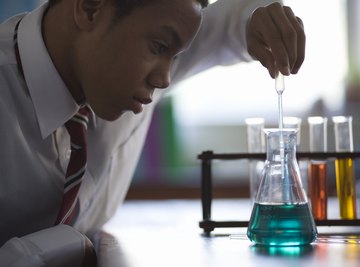
The electrons orbiting around the nucleus of an atom are responsible for that atom's ability to take part in chemical reactions. All kinds of chemical substances can react with each other, from single atoms or ions to complex compounds. Chemical reactions can take place by a number of different mechanisms, and single replacement reactions are one group of reaction types.
Chemical Reactions
Chemical reactions are the foundation of all life processes and also of the changes in the nonliving aspects of different environments all over the planet. In a chemical reaction, chemical species, whether atoms, molecules or complicated compounds, interact with one another and undergo a change into different chemical species. Some reactions can occur spontaneously, without the input of energy, whereas other reactions require that an energy barrier be overcome before the reaction can proceed.
Reaction Types
There are numerous ways in which chemical species can actually interact with each other during a chemical reaction. In synthesis reactions, two or more chemical substances react to form a new chemical compound. In decomposition, on the other hand, a more complex compound actually breaks down into two or more simpler substances. Single and double replacement reactions involve an interchange of chemical species between the reacting substances so that the original reacting compounds become new product compounds.
Single Replacement
Single replacement reactions are simple reactions of the form A + BC gives AC + B. The compound BC reacts with element A and a switch occurs, with element A taking the place of element B in the compound. These reactions result in the formation of a new compound, AC, and the release of element B. A single replacement reaction will only take place when the element being displaced from the compound is less reactive than the element doing the displacing.
Anions and Cations
Anions are atoms or molecules that have a net negative charge, which means that the atom or molecule has acquired one or more charged electrons from another atom or molecule and so now carries an excess of negative charge. Cations, on the other hand, carry a positive charge because they have lost one or more electrons and the positive charge of the protons in the nucleus is not counterbalanced. Cationic and anionic species may be attracted to each other and form a new molecule through ionic bonding.
Anionic and Cationic Single Replacement
In anionic replacement, an anion reacts with another ionic molecule. The ionic molecule consists of an anion and cation and loses its anion, replacing it with the new reacting anion as the reaction proceeds. In cationic replacement, a cation reacts with an ionic molecule composed of an anion and cation and, again, a switch takes places, with the new cation replacing the old cation. In both cases, the result is a new ionic molecule and the release of the species that was replaced.
References
- "Chemistry"; John Olmsted; 2006
About the Author
Emma Francesca has a Bachelor of Science in biology and has been involved in tutoring students and writing educational materials throughout her college career. She is also a working artist with over a decade of experience with numerous art materials and techniques. She has been writing online professionally since 2011.
Photo Credits
Jupiterimages/BananaStock/Getty Images
